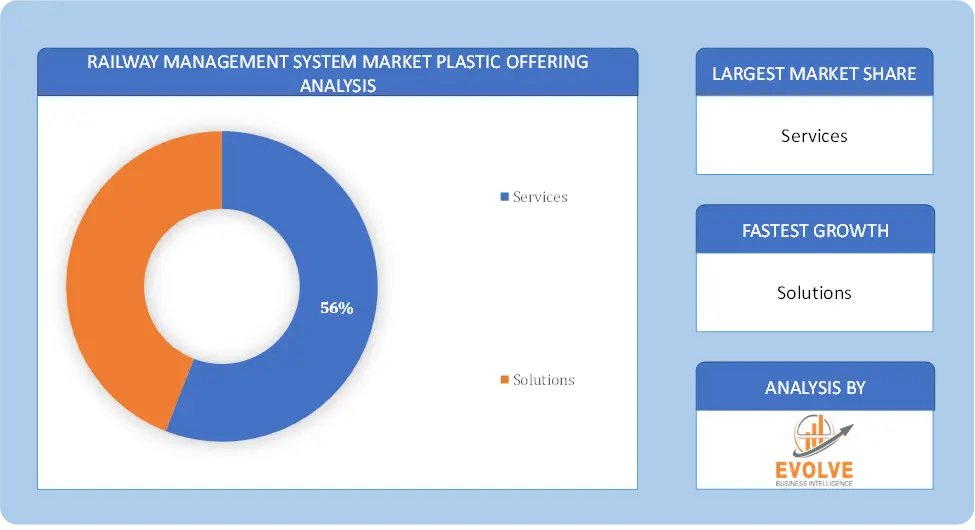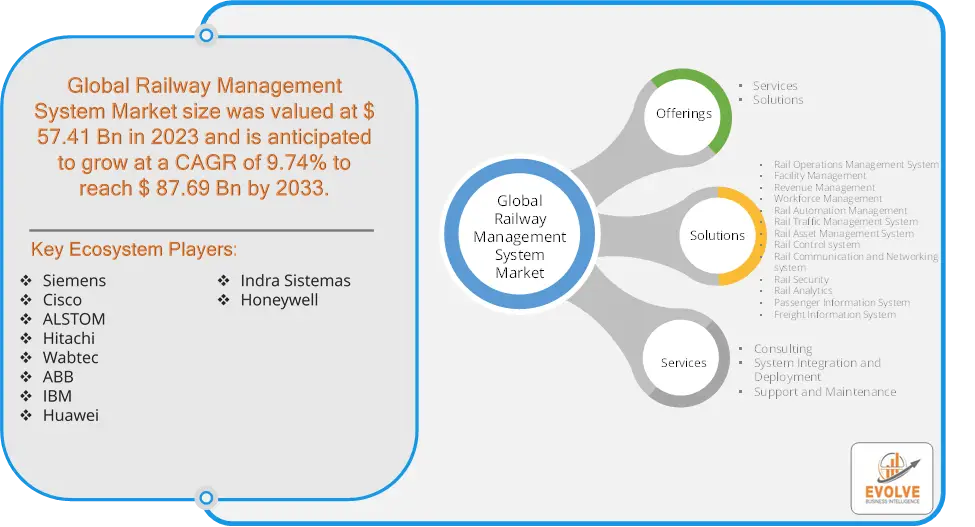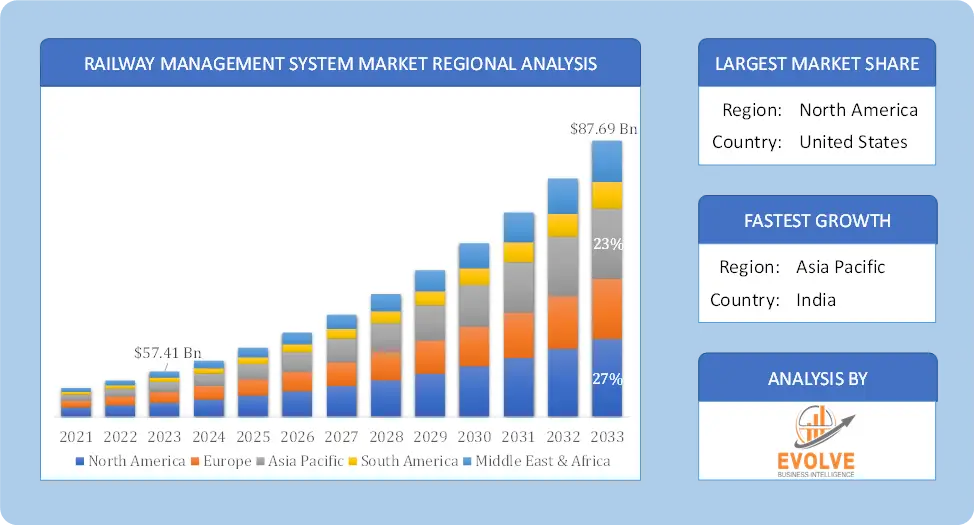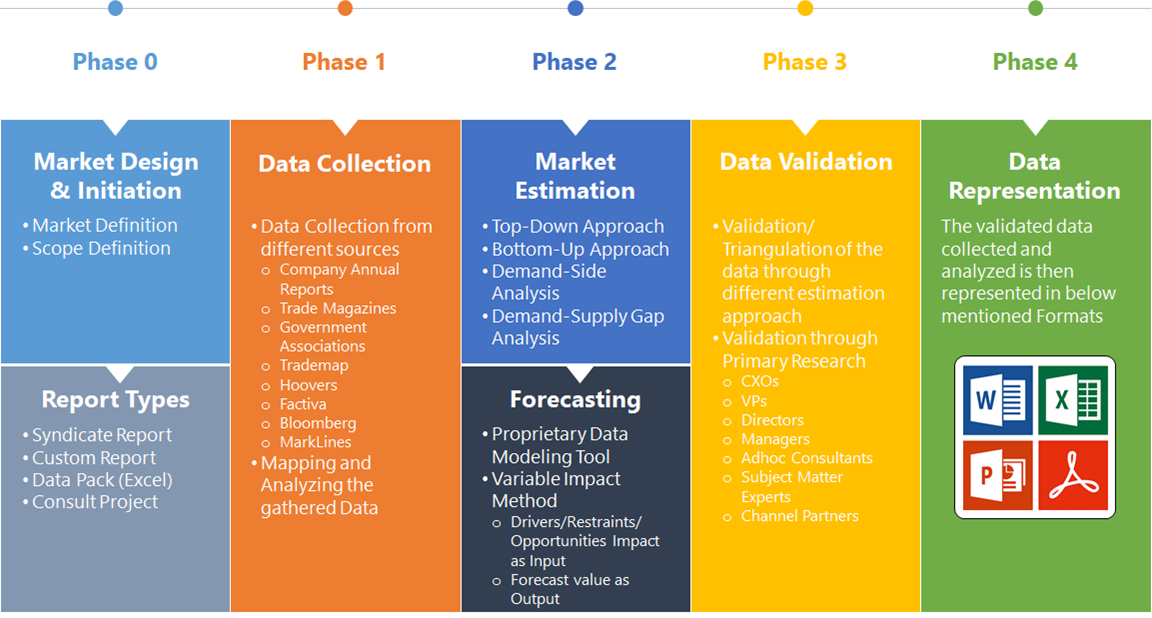Railway Management System Market Overview
The Railway Management System Market Size is expected to reach USD 87.69 Billion by 2033. The Railway Management System industry size accounted for USD 57.41 Billion in 2023 and is expected to expand at a compound annual growth rate (CAGR) of 9.74% from 2023 to 2033. The Railway Management System market encompasses a variety of technologies and services aimed at optimizing the operations, maintenance, and management of railway networks. It includes solutions such as rail traffic management, rail operations management, rail asset management, rail control, and rail maintenance management. These systems enhance the efficiency, safety, and reliability of railway services by integrating advanced technologies like IoT, big data analytics, and artificial intelligence. Key drivers include increasing urbanization, the need for efficient public transportation, and government initiatives to upgrade railway infrastructure. The market is segmented based on solution type, deployment mode, and geographical regions.
Global Railway Management System Market Synopsis
The COVID-19 pandemic has led to supply chain disruptions leading to supply shortages or lower demand in the Railway Management System market. The travel restrictions and social-distancing measures have resulted in a sharp drop in consumer and business spending and this pattern is to continue for some time. The end-user trend and preferences have changed due to the pandemic and have resulted in manufacturers, developers, and service providers to adopt various strategies to stabilize the company.
Global Railway Management System Market Dynamics
The major factors that have impacted the growth of Railway Management System are as follows:
Drivers:
⮚ Increasing Urbanization and Population Growth
With more people moving to urban areas, there is a growing demand for efficient and reliable public transportation systems. Railways, being a major component of urban transit, require sophisticated management systems to handle the increased load and ensure smooth operations.
Restraint:
- Data Security and Privacy Concerns
As railway management systems become more digitized and connected, they become more vulnerable to cyberattacks. Ensuring robust cybersecurity measures is essential but can be costly and complex.
Opportunity:
⮚ Technological Advancements
The development of smart railway infrastructure, including advanced signaling systems, automated trains, and smart ticketing solutions, provides opportunities for modernization and improved operational efficiency. These technologies can enhance service quality, reduce operational costs, and support better resource management.
Railway Management System Market Segment Overview
By Offerings
Based on the Offerings, the market is segmented based on Services, Solutions. Solutions generally dominate. This segment includes comprehensive systems and software that address various aspects of railway management, making it a key driver of market growth.
By Solutions
 Based on the Solutions, the market has been divided into Rail Operations Management System, Facility Management, Revenue Management, Workforce Management,Rail Automation Management, Rail Traffic Management System, Rail Asset Management System, Rail Control system, Rail Communication and Networking system, Rail Security, Rail Analytics, Passenger Information System, Freight Information System. the Rail Operations Management System typically dominates. This solution is essential for optimizing and managing daily railway operations, making it a core component of the market.
Based on the Solutions, the market has been divided into Rail Operations Management System, Facility Management, Revenue Management, Workforce Management,Rail Automation Management, Rail Traffic Management System, Rail Asset Management System, Rail Control system, Rail Communication and Networking system, Rail Security, Rail Analytics, Passenger Information System, Freight Information System. the Rail Operations Management System typically dominates. This solution is essential for optimizing and managing daily railway operations, making it a core component of the market.
By Services
Based on Services, the market has been divided into Consulting, System Integration and Deployment, Support and Maintenance. Support and Maintenance services typically dominate. This segment is crucial for ensuring the continuous operation and reliability of railway systems, making it a significant contributor to overall market revenue.
Global Railway Management System Market Regional Analysis
Based on region, the market has been divided into North America, Europe, Asia-Pacific, the Middle East & Africa, and Latin America. The area of North America is anticipated to dominate the market for the usage of Railway Management System, followed by those in Asia-Pacific and Europe.
 Global Railway Management System North America Market
Global Railway Management System North America Market
North America dominates the Railway Management System market due to several factors. In North America, the Railway Management System market is driven by the need for modernization and efficiency improvements in rail infrastructure. The region’s focus on adopting advanced technologies and enhancing operational capabilities supports market growth. Investments in smart rail systems, automation, and analytics are prominent, alongside efforts to improve safety and reliability.
Global Railway Management System Asia Pacific Market
The Asia-Pacific region has been witnessing remarkable growth in recent years. In the Asia-Pacific region, the Railway Management System market is expanding rapidly due to significant infrastructure development and modernization projects. Countries like China and India are investing heavily in advanced rail technologies to accommodate growing urban populations and improve efficiency. The demand for enhanced safety, automation, and operational management drives market growth.
Competitive Landscape
The competitive landscape includes key players (tier 1, tier 2, and local) having a presence across the globe. Companies such as Siemens, Cisco, ALSTOM, Hitachi, and Wabtec are some of the leading players in the global Railway Management System Industry. These players have adopted partnership, acquisition, expansion, and new product development, among others as their key strategies.
Key Market Players:
- Siemens
- Cisco
- ALSTOM
- Hitachi
- Wabtec
- ABB
- IBM
- Huawei
- Indra Sistemas
- Honeywell
Key development:
In September 2022, Hitachi expanded its Railway Management System offerings by launching a new suite of advanced rail solutions aimed at enhancing operational efficiency and integrating smart technologies for improved rail infrastructure management.
Scope of the Report
Global Railway Management System Market, by Offerings
- Services
- Solutions
Global Railway Management System Market, by Solutions
- Rail Operations Management System
- Facility Management
- Revenue Management
- Workforce Management
- Rail Automation Management
- Rail Traffic Management System
- Rail Asset Management System
- Rail Control system
- Rail Communication and Networking system
- Rail Security
- Rail Analytics
- Passenger Information System
- Freight Information System
Global Railway Management System Market, by Services
- Consulting
- System Integration and Deployment
- Support and Maintenance
Global Railway Management System Market, by Region
- North America
- US
- Canada
- Mexico
- Europe
- UK
- Germany
- France
- Italy
- Spain
- Benelux
- Nordic
- Rest of Europe
- Asia Pacific
- China
- Japan
- South Korea
- Indonesia
- Austalia
- Malaysia
- India
- Rest of Asia Pacific
- South America
- Brazil
- Argentina
- Rest of South America
- Middle East & Africa
- Saudi Arabia
- UAE
- Egypt
- South Africa
- Rest of Middle East & Africa
| Parameters | Indicators |
|---|---|
| Market Size | 2033: $87.69 Billion |
| CAGR | 9.74% CAGR (2023-2033) |
| Base year | 2022 |
| Forecast Period | 2023-2033 |
| Historical Data | 2021 |
| Report Coverage | Revenue Forecast, Competitive Landscape, Growth Factors, and Trends |
| Key Segmentations | Offerings, Solutions, Services |
| Geographies Covered | North America, Europe, Asia-Pacific, Latin America, Middle East, Africa |
| Key Vendors | Siemens, Cisco, ALSTOM, Hitachi, Wabtec, ABB, IBM, Huawei, Indra Sistemas, Honeywell |
| Key Market Opportunities | The increasing GDP of the APAC countries is also expected to contribute to market growth |
| Key Market Drivers | The rise in demographic growth, hyper-urbanization, increasing adoption of IoT as well as automation technologies to enhance optimization and emerging trend of smart cities are expected to be the major factors driving the growth of the railway management system market. |
REPORT CONTENT BRIEF:
- High-level analysis of the current and future Railway Management System Industry trends and opportunities
- Detailed analysis of current market drivers, restraining factors, and opportunities analysis in the future
- Historical market size for the year 2021, and forecast from 2023 to 2033
- Railway Management System market share analysis for each segment
- Competitor analysis with a comprehensive insight into its product segment, financial strength, and strategies adopted.
- Identifies key strategies adopted by the key players including new product development, mergers and acquisitions, joint ventures, collaborations, and partnerships.
- To identify and understand the various factors involved in the global Railway Management System market affected by the pandemic
- To provide year-on-year growth from 2022 to 2033
- To provide short-term, long-term, and overall CAGR comparison from 2022 to 2033.
- Provide Total Addressable Market (TAM) for the Global Railway Management System Market.









